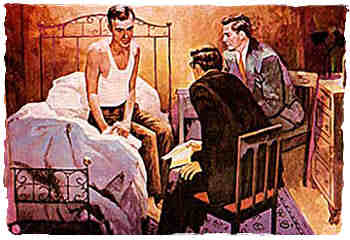Saturday Evening Post Article Continued – Page 2

He next makes a short moral inventory of himself with the private aid of another person – one of his A.A. sponsors, a priest, a minister a psychiatrist, or anyone else he fancies. If it gives him any relief, he may get up at a meeting and recite his misdeed, but he is not required to do so. He restores what he may have stolen while intoxicated and arranges to pay off old debts and to make good on rubber checks; he makes amends to persons he has abused and in general, cleans up his past as well as he is able to. It is not uncommon for his sponsors to lend him money to help out in the early stages.
This catharsis is regarded as important because of the compulsion, which a feeling of guilt exerts in the alcoholic obsession. As nothing tends to push an alcoholic toward the bottle more than personal resentments, the pupil also makes out a list of his grudges and resolves not to be stirred by them. At this point, he is ready to start working on other, active alcoholics. By the process of extroversion, which the work entails, he is able to think less of his own troubles.
The more drinkers he succeeds in swinging into Alcoholics Anonymous, the greater his responsibility to the group becomes. He can’t get drunk now without injuring the people who have proved themselves his best friends. He is beginning to grow up emotionally and to quit being a leaner. If raised in an Orthodox Church, he usually, but not always, becomes a regular communicant again.
SIMULTANEOUSLY WITH the making over of the alcoholic goes the process of adjusting his family to his new way of living. The wife or husband of an alcoholic, and the children, too, frequently become neurotics from being exposed to drinking excesses over a period of years. Reeducation of the family is an essential part of a follow-up program, which has been devised.
Alcoholics Anonymous, which is synthesis of old ideas rather than a new discovery, owes its existence to the collaboration of a New York stockbroker and an Akron physician. Both alcoholics, they met for the first time a little less than six years ago. In thirty-five years of periodic drinking, Dr. Armstrong, to give the physician a fictitious name, had drunk himself out of most of his practice. Armstrong had tried everything, including the Oxford Group, and had shown no improvement. On Mother’s Day 1935, he staggered home, in typical drunk fashion, lugging an expensive potted plant, which he placed in his wife’s lap. Then he went upstairs and passed out.
At that moment, nervously pacing the lobby of an Akron hotel, was the broker from New York, whom we shall arbitrarily call Griffith. Griffith was in a jam. In an attempt to obtain control of a company and rebuild his financial fences, he had come out to Akron and engaged in a fight for proxies. He had lost the fight. His hotel bill was unpaid. He was almost flat broke. Griffith wanted a drink.
During his career in Wall Street, Griffith had turned some sizable deals and had prospered, but, through ill-timed drinking bouts, had lost out on his main chances. Five months before coming to Akron, he had gone on the water wagon through the ministration of the Oxford Group in New York. Fascinated by the problem of alcoholism, he had many times gone back as a visitor to a Central Park West detoxicating hospital, where he had been a patient, and talked to the inmates. He effected no recoveries, but found that by working on other alcoholics he could stave off his own craving.
A stranger in Akron, Griffith knew no alcoholics with whom he could wrestle. A church directory, which hung in the lobby opposite the bar, gave him an idea. He telephoned one of the clergymen listed and through him got in touch with a member of the local Oxford Group. This person was a friend of Dr. Armstrong’s and was able to introduce the physician and the broker at dinner. In this manner, Dr. Armstrong became Griffith’s first real disciple. He was a shaky one at first. After a few weeks of abstinence, he went east to a medical convention and came home in a liquid state. Griffith, who had stayed in Akron to iron out some legal tangles arising from the proxy battle, talked him back to sobriety. That was on June 10, 1935. The nips the physician took from a bottle proffered by Griffith on that day were the last drinks he ever took.
GRIFFITH’S lawsuits dragged on, holding him over in Akron for six months. He moved his baggage to the Armstrong home, and together the pair struggled with other alcoholics. Before Griffith went back to New York, two more Akron converts had been obtained. Meanwhile, both Griffith and Dr. Armstrong had withdrawn from the Oxford Group, because they felt that its aggressive evangelism and some of its other methods were hindrances in working with alcoholics. They put their own technique on a strict take-it-or-leave-it basis and kept it there.
Progress was slow. After Griffith had returned East, Dr. Armstrong and his wife, a Wellesley graduate, converted their home into a free refuge for alcoholics and an experimental laboratory for the study of the guest’s behavior. One of the guest, who unknown to his hosts, was a manic-depressive as well as an alcoholic, ran wild one night with a kitchen knife. He was overcome before he stabbed anyone. After a year and a half, a total of ten persons had responded to the program and were abstaining. What was left of the family savings had gone into the work. The physician’s new sobriety caused a revival in his practice, but not enough of one to carry the extra expense. The Armstrongs, nevertheless, carried on, on borrowed money. Griffith, who had a Spartan wife, too, turned his Brooklyn home into a duplicate of Akron image. Mrs. Griffith, a member of an old Brooklyn family, took a job in a department store and in her spare time played nurse to inebriates. The Griffiths also borrowed, and Griffith managed to make odd bits of money around the brokerage houses. By the spring of 1939, The Armstrongs and the Griffiths had between them cozened about one hundred alcoholics into sobriety.
IN A BOOK, which they published at that time, the recovered drinkers described the cure program and related their personal stories. The title was Alcoholics Anonymous. It was adopted as a name for the movement itself, which up to then had none. As the book got into circulation, the movement spread rapidly. Today, Dr. Armstrong is still struggling to patch up his practice. The going is hard. He is in debt because of his contributions to the movement and the time he devotes gratis to alcoholics. Being a pivotal man in the group, he is unable to turn down the requests for help, which flood his office.
Griffith is even deeper in the hole. For the past two years, he and his wife have had no home in the ordinary sense of the word. In a manner reminiscent of the primitive Christians, they have moved about, finding shelter in the home of A.A. colleagues and sometimes wearing borrowed clothing.
Having got something started, both the prime movers want to retire to the fringe of their movement and spend more time getting back on their feet financially. They feel that the way the thing is set up, it is virtually self-operating and self-multiplying. Because of the absence of figureheads and the fact that there is no formal body of belief to promote, they have no fears that Alcoholics Anonymous will degenerate into a cult.
The self-starting nature of the movement is apparent from letters in the files of the New York office. Many persons have written in saying that they stopped drinking as soon as they read the book, and made their homes meeting places for small local chapters. Even a fairly large unit, in Little Rock, got started in this way. An Akron civil engineer and his wife, in gratitude for his cure four years ago, have been steadily taking alcoholics into their home. Out of thirty-five such wards, thirty-one have recovered.
TWENTY PILGRIMS from Cleveland caught the idea in Akron and returned home to start a group of their own. From Cleveland, by various means, the movement has spread to Chicago, Detroit, St. Louis, Los Angeles, Indianapolis, Atlanta, San Francisco, Evansville, and other cities. An alcoholic Cleveland newspaperman with a surgically collapsed lung moved to Houston for his health. He got a job on a Houston paper, and through a series of articles, which he wrote for it, started an A.A. unit, which now has thirty-five members. One Houston member has moved to Miami and is now laboring to snare some of the more eminent winter-colony lushes. A Cleveland traveling salesman is responsible for starting small units in many different parts of the county. Fewer than half of the A.A. members has ever seen Griffith or Dr. Armstrong.
To an outsider who is mystified, as most of us are, by the antics of problem-drinking friends, the results, which have been achieved, are amazing. This is especially true of the more virulent cases, a few of which are herewith sketched under names that are not their own.
Sara Martin was a product of the F. Scott Fitzgerald era. Born of wealthy parents in a Western City, she went to Eastern boarding schools and “finished” in France. After making her debut, she married. Sara spent her nights drinking and dancing until daylight. She was known as a girl who could carry a lot of liquor. Her husband had a weak stomach, and she became disgusted with him. They were quickly divorced. After her father’s fortune had been erased in 1929, Sara got a job in New York and supported herself. In 1932, seeking adventure, she went to Paris to live and set up a business of her own, which was successful. She continued to drink heavily and stayed drunk longer than usual. After a spree in 1933, she was informed that she had tried to throw herself out a window. During another bout, she did jump or fall – she doesn’t remember which – out of a first-floor window. She landed face first on the sidewalk and was laid up for fix months of bone setting, dental work, and plastic surgery.
IN 1936, Sara Martin decided that if she changed her environment by returning to the United States, she would be able to drink normally. This childish faith in geographical change is a classic delusion, which all alcoholics get at one time, or another. She was drunk all the way home on the boat. New York frightened her and she drank to escape it. Her money ran out and she borrowed from friends. When the friends cut her, she hung around Third Avenue bars, cadging drinks from strangers. Up to this point she had diagnosed her trouble as a nervous breakdown. Not until she had committed herself to several sanitariums did she realize, through reading, that she was an alcoholic. On advice of a staff doctor, she got in touch with an Alcoholics Anonymous group. Today, she has another good job and spends many of her nights sitting on hysterical women drinkers to prevent them from diving out of windows. In her late thirties, Sarah Martin is an attractively serene woman. The Paris surgeons did handsomely by her.
Watkins is a shipping clerk in a factory. Injured in an elevator mishap in 1927, he was furloughed with pay by a company, which was thankful that he did not sue for damages. Having nothing to do during a long convalescence, Watkins loafed in speakeasies. Formerly a moderate drinker, he started to go on drunks lasting several months. His furniture went for debt, and his wife fled, taking their three children. In eleven years, Watkins was arrested twelve times and served eight workhouse sentences. Once, in an attack of delirium tremens, he circulated a rumor among the prisoners that the county was poisoning the food in order to reduce the workhouse population and save expenses. A mess-hall riot resulted. In another fit of D.T.’s, during which he thought the man in the cell above was trying to pour hot lead on him, Watkins slashed his own wrists and throat with a razor blade. While recuperating in an outside hospital, with eighty-six stitches, he swore never to drink again. He was drunk before the final bandages were removed. Two years ago, a former drinking companion got him to Alcoholics Anonymous, and he hasn’t touched liquor since. His wife and children have returned, and the home has new furniture. Back at work, Watkins has paid off the major part of $2,000 in debts and petty alcoholic thefts and has his eye on a new automobile.
AT TWENTY-TWO, Tracy, a precocious son of well-to-do parents, was credit manager for an investment-banking firm whose name has become a symbol of the money-mad twenties. After the firm’s collapse during the stock market crash, he went into advertising and worked up to a post, which paid him $23,000 a year. On the day his son was born, Tracy was fired. Instead of appearing in Boston to close a big advertising contract, he had gone on a spree and had wound up in Chicago, losing out on the contract. Always a heavy drinker, Tracy became a bum. He tippled on Canned Heat and hair tonic and begged from cops, who are always easy touches for amounts up to a dime. On one sleety night, Tracy sold his shoes to buy a drink, putting on a pair of rubbers he had found in a doorway and stuffing them with paper to keep his feet warm.
He started committing himself to sanitariums, more to get in out of the cold than anything else. In one institution, a physician got him interested in the A.A. program. As part of it, Tracy, a Catholic made a general confession and returned to the church, which he had long since abandoned. He skidded back to alcohol a few times, but after a relapse in February 1939, Tracy took no more drinks. He has since then beat his way up again to $18,000 a year in advertising.
Victor Hugo would have delighted in Brewster, a heavy-thewed adventurer who took life the hard way. Brewster was a lumberjack; cowhand, and wartime aviator. During the postwar era, he took up flask toting and was soon doing a Cook’s tour of the sanitariums. In one of them, after hearing about shock cures, he bribed the Negro attendant in the morgue, with gifts of cigarettes, to permit him to drop in each afternoon and meditate over a cadaver. The plan worked well until one day he cam upon a dead man who, by a freak facial contortion, wore what looked like a grin. Brewster met up with the A.A.s in December 1938, and after achieving abstinence, got a sales job, which involved much walking. Meanwhile, he had got cataracts on both eyes. One was removed, giving him distance sight with the aid of thick-lens spectacles. He used the other eye for close-up vision, keeping it dilated with an eye-drop solution in order to avoid being run down in traffic. The he developed a swollen, or milk, leg. With these disabilities, Brewster tramped the streets for six months before he caught up with his drawing account. Today, at fifty, still hampered by his physical handicaps, he is making his calls and earning around $400 a month.
FOR THE Brewsters, the Martins, the Watkinses, the Tracys, and the other reformed alcoholics, congenial company is now available wherever they happen to be. In the larger cities, A.A.s meet one another daily at lunch in favored restaurants. The Cleveland groups give big parties on New Year’s and other holidays, at which gallons of coffee and soft drinks are consumed. Chicago holds open house on Friday, Saturday and Sunday – alternating, on the North, West, and South Sides – so that no lonesome A.A. need revert to liquor over the weekend for lack of companionship. Some play cribbage or bridge, the winner of each hand contributing to a kitty for paying of entertainment expenses. The others listen to the radio, dance, eat, or just talk. All alcoholics, drunk or sober, like to gab. They are among the most society-loving people in the world, which may help to explain why they got to be alcoholics in the first place.
Jack Alexander
The Saturday Evening Post
March 1, 1941
The History of How The Article Came To Be
Jack Alexander of SatEvePost Fame Thought A.A.s Were Pulling His Leg
AA Grapevine, May, 1945
Ordinarily, diabetes isn’t rated as one of the hazards of reporting, but the Alcoholics Anonymous article in the Saturday Evening Post came close to costing me my liver, and maybe A.A. neophytes ought to be told this when they are handed copies of the article to read. It might impress them. In the course of my fact gathering, I drank enough Coca-Cola, Pepsi-Cola, ginger ale, Moxie and Sweetie to float the Saratoga. Then there was the thickly frosted cake so beloved of A.A. gatherings, and the heavily sweetened coffee, and the candy. Nobody can tell me that alcoholism isn’t due solely to an abnormal craving for sugar, not even a learned psychiatrist. Otherwise the A.A. assignment was a pleasure.
It began when the Post asked me to look into A.A. as a possible article subject. All I knew of alcoholism at the time was that, like most other non-alcoholics, I had had my hand bitten (and my nose punched) on numerous occasions by alcoholic pals to whom I had extended a hand–unwisely, it always seemed afterward. Anyway, I had an understandable skepticism about the whole business.
My first contact with actual A.A.s came when a group of four of them called at my apartment one afternoon. This session was pleasant, but it didn’t help my skepticism any. Each one introduced himself as an alcoholic who had gone “dry,” as the official expression has it. They were good-looking and well-dressed and, as we sat around drinking Coca-Cola (which was all they would take), they spun yarns about their horrendous drinking misadventures. The stories sounded spurious, and after the visitors had left, I had a strong suspicion that my leg was being pulled. They had behaved like a bunch of actors sent out by some Broadway casting agency.
Next morning I took the subway to the headquarters of Alcoholics Anonymous in downtown Manhattan, where I met Bill W. This Bill W. is a very disarming guy and an expert at indoctrinating the stranger into the psychology, psychiatry, physiology, pharmacology and folklore of alcoholism. He spent the good part of a couple of days telling me what it was all about. It was an interesting experience, but at the end of it my fingers were still crossed. He knew it, of course, without my saying it, and in the days that followed he took me to the homes of some of the A.A.s, where I got a chance to talk to the wives, too. My skepticism suffered a few minor scratches, but not enough to hurt. Then Bill shepherded me to a few A.A. meetings at a clubhouse somewhere in the West Twenties. Here were all manner of alcoholics, many of them, the nibblers at the fringe of the movement, still fragrant of liquor and needing a shave. Now I knew I was among a few genuine alcoholics anyway. The bearded, fume-breathing lads were A.A. skeptics, too, and now I had some company.
The week spent with Bill W. was a success from one standpoint. I knew I had the makings of a readable report but, unfortunately, I didn’t quite believe in it and told Bill so. He asked why I didn’t look in on the A.A.s in other cities and see what went on there. I agreed to do this, and we mapped out an itinerary. I went to Philadelphia first, and some of the local A.A.s took me to the psychopathic ward of Philadelphia General Hospital and showed me how they work on the alcoholic inmates. In that gloomy place, it was an impressive thing to see men who had bounced in and out of the ward themselves patiently jawing a man who was still haggard and shaking from a binge that wound up in the gutter.
Akron was the next stop. Bill met me there and promptly introduced me to Doc S., who is another hard man to disbelieve. There were more hospital visits, an A.A. meeting, and interviews with people who a year or two before were undergoing varying forms of the blind staggers. Now they seemed calm, well-spoken, steady-handed and prosperous, at least mildly prosperous.
Doc S. drove us both from Akron to Cleveland one night and the same pattern was repeated. The universality of alcoholism was more apparent here. In Akron it had been mostly factory workers. In Cleveland there were lawyers, accountants and other professional men, in addition to laborers. And again the same stories. The pattern was repeated also in Chicago, the only variation there being the presence at the meetings of a number of newspapermen. I had spent most of my working life on newspapers and I could really talk to these men. The real clincher, though, came in St. Louis, which is my hometown. Here I met a number of my own friends who were A.A.s, and the last remnants of skepticism vanished. Once rollicking rumpots, they were now sober. It didn’t seem possible, but there it was.
When the article was published, the reader-mail was astonishing. Most of it came from desperate drinkers or their wives, or from mothers, fathers or interested friends. The letters were forwarded to the A.A. office in New York and from there were sent on to A.A. groups nearest the writers of the letters. I don’t know exactly how many letters came in, all told, but the last time I checked, a year or so ago, it was around 6,000. They still trickle in from time to time, from people who have carried the article in their pockets all this time, or kept it in the bureau drawer under the handkerchief case intending to do something about it.
I guess the letters will keep coming in for years, and I hope they do, because now I know that every one of them springs from a mind, either of an alcoholic or of someone close to him, which is undergoing a type of hell that Dante would have gagged at. And I know, too, that this victim is on the way to recovery, if he really wants to recover. There is something very heartening about this, particularly in a world which has been struggling toward peace for centuries without ever achieving it for very long periods of time.
Jack Alexander
Philadelphia, Pennsylvania




